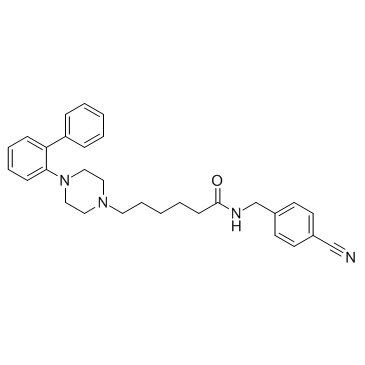1052147-86-0
| Name | LP-211 |
|---|---|
| Synonyms |
6-[4-(2-Biphenylyl)-1-piperazinyl]-N-(4-cyanobenzyl)hexanamide
LP-211 1-Piperazinehexanamide, 4-[1,1'-biphenyl]-2-yl-N-[(4-cyanophenyl)methyl]- MFCD22690843 |
| Description | LP-211 is a selective and blood−brain barrier penetrant 5-HT7 receptor agonist, with a Ki of 0.58 nM, with high selectivity over 5-HT1A receptor (Ki, 188 nM) and D2 receptor (Ki, 142 nM). |
|---|---|
| Related Catalog | |
| Target |
Ki: 0.58 nM (5-HT7 receptor), 188 nM (5-HT1A receptor), 142 nM (D2 receptor)[1] |
| In Vitro | LP-211 is a selective 5-HT7 receptor agonist, with a Ki of 0.58 nM, 324- and 245-fold selectivity over 5-HT1A receptor (Ki, 188 nM) and D2 receptor (Ki, 142 nM). LP-211 shows agonist properties with an EC50 of 0.6 μM[1]. |
| In Vivo | LP-211 (10 mg/kg, i.p.) rapidly reaches the systemic circulation in the mouse, with mean Cmax of 0.76 ± 0.32 μg/mL at 30 min[1]. LP-211 (0.003-0.3 mg/kg, i.p.) significantly increases the micturition volume in a dose-dependent manner, and causes significant increases in voiding efficiency in spinal cord-injured (SCI) rats, and such effects can be completely reversed by SB-269970[2]. LP-211 (0.25 and 0.50 mg/kg i.p.) improves consolidation of chamber-shape memory in rats, resulting in significant novelty-induced hyperactivity and recognition[3]. |
| Kinase Assay | Binding of [3H]-LSD at rat cloned 5-HT7 receptor is performed in the assay. In 1 mL of incubation buffer (50 mM Tris, 10 mM MgCl2 and 0.5 mM EDTA, pH 7.4) are suspended 30 μg of membranes, 2.5 nM [3H]-LSD, LP-211 (6−9 concentrations). The samples are incubated for 60 min at 37°C. The incubation is stopped by rapid filtration on GF/A glass fiber filters (presoaked in 0.5% polyethylenimine for 30 min). The filters are washed with 3 × 53 mL of ice-cold buffer (50 mM Tris, pH 7.4). Nonspecific binding is determined in the presence of 10 μM 5-CT. Approximately 90% of specific binding is determined under these conditions[1]. |
| Animal Admin | Rats[3] Thirty male adult Wistar rats (300-450 g) are assessed for novelty preference behavior after acute treatment (administered immediately after the training session and 24 h before the test session). After a 4 weeks' wash out, the rPDT is conducted to evaluate attraction from a greater/uncertain reward, with a sub-chronic treatment (five injections, immediately after sessions which follow the indifferent point). Food restriction, imposed by the experimenter through a limited quantity of food given at the end of each rPDT session, is applied to increase motivation to work for food delivery. All behavioral tests take place between 9:30 am and 4:00 pm. Rats are randomly assigned to treatment (LP-211 at 0.25 or 0.50 mg/kg i.p.) and control groups (injection volume 10 mL/kg; n = 10 per group). The brain penetrant 5-HT7R agonist LP-211 is dissolved in a vehicle solution of 1% dimethyl sulfoxide (DMSO) in saline (0.9% NaCl). Control group receives the vehicle strictly in the same conditions[3]. |
| References |
| Density | 1.2±0.1 g/cm3 |
|---|---|
| Boiling Point | 714.8±60.0 °C at 760 mmHg |
| Molecular Formula | C30H34N4O |
| Molecular Weight | 466.617 |
| Flash Point | 386.1±32.9 °C |
| Exact Mass | 466.273254 |
| LogP | 4.58 |
| Vapour Pressure | 0.0±2.3 mmHg at 25°C |
| Index of Refraction | 1.632 |
| Storage condition | 2-8℃ |
| RIDADR | NONH for all modes of transport |
|---|
